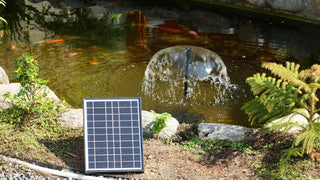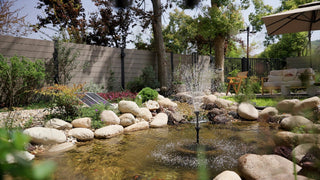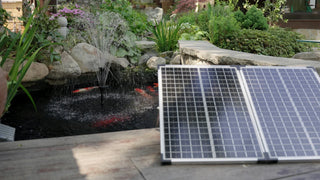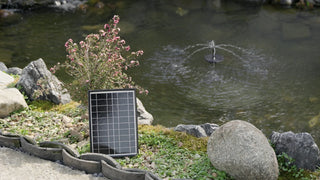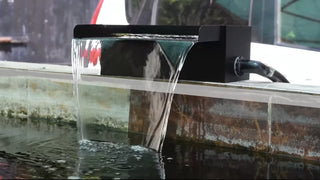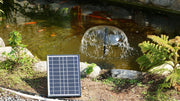
Nothing's more aggravating than going out into your garden, expecting to see your once-bubbling solar fountain peacefully dead. Solar fountains are not only a pretty face for many homeowners' homes—they're a haven for relaxation and a sanity-retainer for pond health. When they do fail, you'll be sitting there trying to decide whether the pump's blown, whether the panel's dead, or whether you've done something wrong. The fact is that many pond fountain issues are simple to fix with a little careful observing and regular upkeep. This book will walk you through the causes of most of your problems, how to diagnose your setup, and when you will need to consider replacing it.
Common Issues (Panel, Debris, Cloudy Days)
Rather than going straight to advanced repairs, start with the basics. Solar fountains rely on a well-balanced combination of clean panels, free-flowing pumps, and adequate sunlight. Common failures are:
- Dirty or clogged panels: Dust, pollen, or bird droppings cut efficiency by more than half.
- Grit-filled pump: Leaves, algae, or grit will clog the impeller, restricting flow.
- Cloudy weather: Solar pumps, especially direct-sun models, naturally run less on cloudy days.
- Low power fountain symptoms: Spray failing, unstable on, or ceasing altogether usually indicate blockage of flow or power.
Poposoap creates environmentally responsible, low-upkeep fountains. Its solar pumps and filter boxes come with protective screens and clean-in-place options to help reduce clogging potential and make your fountain last longer.
How to Test the Panel

If the fountain will not run, the second trouble-shooting step beyond the solar pump is to check the solar panel. First, check the location of the panel. Is it receiving direct sun for six or more hours a day? Adjust it and orient it toward noon sun, as even partial shade from trees or patio furniture cuts output significantly.
To test for function, disconnect the pump and hook the panel directly through. If the panel does produce power in direct sunlight, then something is wrong with the pump or wiring. Otherwise, carefully wash the panel gently with a soft cloth and mild soap, then retest. Failure to function repeatedly after cleaning generally signifies panel degradation through age.
Poposoap's panels are built to withstand the outdoors, but like any solar component, the periodic cleaning is necessary to ensure maximum efficiency.
Filter Cleaning
Ninety-nine times out of one hundred, what seems to be a catastrophic failure is a clogged filter. Pond water is full of organic matter—leaves, algae, and even dust—that find their way into the pump housing. A clogged filter will create poor spray or outright shutdown.

The solution is simple:
- Remove the pump from the fountain.
- Open up the filter housing and rinse the sponge or mesh screen in pond water (never tap water, which kills beneficial bacteria if your fountain also doubles as a filter).
- Examine the impeller for trapped grit and rinse it off gently.
Poposoap filter boxes contain simple-to-clean reusable sponges and ceramic media that are easy to remove, wash, and reinstall. With this clever design, cleaning is a five-minute task, not a chore.
Battery vs Direct Sun
Understanding how your fountain is powered is the secret to fixing complaints of low power fountains.
- Direct Sun Models: They will only function if the panel is exposed to sunlight. On cloudy days or shaded, performance will naturally drop. They're perfect for those who appreciate simplicity and environmental friendliness.
- Battery-Backup Models: These are storage batteries for surplus solar power, allowing for evening or off-and-on cloud use. Batteries do wear out over time and will eventually need to be replaced.
Poposoap offers both solar fountain designs, so it is easy to choose a system that fits your area and your desires. Most households will enjoy a battery model for more consistent enjoyment, whereas direct-sun designs are best for minimalists who want low-maintenance pond ornaments.
When to Replace Part
Even with proper care, solar fountains don't last forever. Moving parts like impellers and filters wear out, and solar panels eventually lose efficiency. Signs that replacement should be done include:
- The fountain is producing only a fraction of its original output, even following maintenance cleaning.
- The solar panel produces no output even with full sun exposure and cleaning.
- The battery (if in back-up models) fails to hold a charge and results in repeated turning off.
- Continuous noise, rattling, or overheating from the pump.
Poposoap's handbook instructs to swap out clogged sponges and media regularly, whereas pumps and panels last through several seasons provided they are well cared for. Their modular design gives you the freedom to typically be able to swap one component rather than the entire system, which aids in waste conservation and minimizing the cost of maintenance.

Final Thoughts
A dead solar fountain is not the end of the world. In all but the most serious cases, easy fixes—pans cleaning, filter washing, or resettling for increased lighting—fix the problem. Understanding whether your system is battery-backed or direct-sun also aids in setting expectations and guiding your next step with solar fountain repair.
By investing in good products like Poposoap solar fountains and filter systems, you will minimize downtime and keep your fountain running to maximize both beauty and pond health. With upkeep, you will be able to enjoy a hassle-free water feature, avoiding the common errors that bring frustration to so many pond owners.


